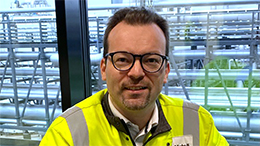On 20 September 2023, the new Kemi bioproduct mill and paperboard mill expansion were started up as planned.
 Tomi SeppäAccording to Mill Manager Tomi Seppä, the mood at the new mill is very enthusiastic now that the project stage has been successfully completed.
Tomi SeppäAccording to Mill Manager Tomi Seppä, the mood at the new mill is very enthusiastic now that the project stage has been successfully completed.
“The mill has started up, and during the production stage, we’ll be developing the mill’s operating models, production, quality, environmental performance and cost-effectiveness in accordance with our targets for start-up,” says Mill Manager Tomi Seppä.
In the next stage, the goal is to increase production so that the bioproduct mill reaches full capacity a year from now, in the autumn of 2024.
During the project stage, Seppä was responsible for HR operations such as developing the operating personnel’s competence, combating the grey economy, dealing with the environmental permit and handling tasks related to environmental performance.
“In addition, much of my work during the project stage was connected with preparing the operational activities of the mill’s production stage. This included the mill organisation’s operating models and the conclusion of service agreements. In practice, I dealt with preparations for everything related to operating the mill.
Emphasis on personnel training
The bioproduct mill is fully fossil free and will meet the most stringent environmental norms and technical requirements far into the future. The mill operates a fully-fledged circular economy, as all the wood raw material and production side streams are efficiently used for various bioproducts and bioenergy. The autonomous cranes used in wood processing, the in-house sulphuric acid plant, and the closed cooling water cycle represent state-of-the-art techniques.
“We have also invested heavily in developing our personnel’s competence. The best practical training comes from running the mill during the production stage. Supervisors have drawn up personal competence development plans and paths for professional competence development for every employee. We will be monitoring the development of competence and operating models in various monitoring and steering groups.”
In the spring of 2023, supervisors participated in change workshops, which discussed the key aspects of the mill’s production stage, including safety, competence development and environmental performance.
Change workshops will continue to be held during the production stage to ensure harmonised and effective leadership throughout the organisation.
At the bioproduct mill, safety is a priority that guides all operations.
“In safety, we focus on high-quality and effective proactive work. Among other things, this means identifying the risks related to tasks in advance and performing corrective measures to avoid hazardous situations in the first place. Since the operating environment is new to all of us, everyone must take an active approach.”
Routine days are the best
Mill Manager Tomi Seppä’s workdays are varied in every aspect. They are filled with matters related to safety, the personnel, the economy, procurement and the environment.
“During this start-up stage, much of my workday is taken up with field tours, as well as systematic status reports describing the development of the mill’s production, product quality and environmental performance. Meeting our employees, asking how they’re doing and contributing to a positive spirit are other important elements of my work.”
In Seppä’s opinion, the most important characteristics needed in his job are a systematic approach, the ability to grasp the big picture, good cooperation skills, and the ability to react quickly and determinedly when necessary.
“I take a solution-oriented approach to challenges and problems and Iook ahead to solve problems as quickly as possible. By identifying the root cause, we can prevent the problem recurring.”
During the project stage, Seppä most enjoyed normal routine days.
“What I liked most was when things progressed as planned, and we achieved results together.”
During the project, Seppä also worked as project manager in the construction of the new operating office.
“What’s new is that we all work in the same open-plan office now, and the control rooms of the fiberline and recovery line are also housed in the same facilities. This enables closer contacts and a better information flow,” says Seppä.
Source: Metsä Fibre













